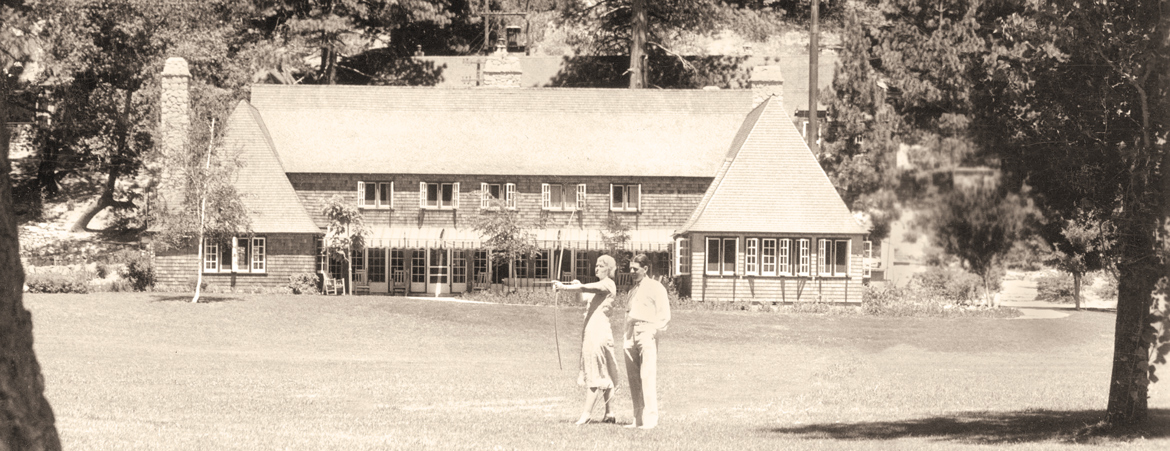


In the early 1920s, Lake Arrowhead was a resort for Hollywood’s rich and famous. In those days, there were no roads leading to the North Shore Tavern (present-day Main Lodge) on the north shore of the lake. The tavern offered relaxation and outdoor activities for those who braved the boat trip across the lake from the Lake Arrowhead Village.
The construction of Cedar Lodge during the 1940s allowed for the housing of the tavern’s employees, many of whom lived in Palm Springs and moved to Lake Arrowhead where the temperature was much cooler. In the years that followed, Cedar Lodge served as a local schoolhouse and later as the Lake Arrowhead Yacht Club.
The North Shore Tavern was owned by the Los Angeles Turf Club, which also owned Lake Arrowhead and the Santa Anita Race Track. In 1957, the Los Angeles Turf Club decided to sell the lake and donate portions of their property holdings. The North Shore Tavern was offered to the University of California Regents, which gladly accepted the donation.
Over the years, the property operated as a conference center under the direction of different University of California campuses. In 1982, leadership of the property was transferred to the University of California, Los Angeles (UCLA).
In 1984, the conference center was expanded to include three new spacious conference rooms in the Main Lodge, as well as 32 luxurious two-story chalets. By 1995, to meet the growing demands of the venue’s popularity, it underwent extensive guest room renovations, as well as the construction of 42 new chalets.
Today, the UCLA Lake Arrowhead Lodge is a thriving venue for conferences, retreats, solo adventurers, vacationing couples and families. Our stays include overnight accommodations in cozy chalets and access to an array of outdoor activities, including the new Lake Arrowhead History Walk.

This popular Southern California destination was once a place traversed by Native Americans, Spanish missionaries, American capitalists, grizzly bear hunters, cattle rustlers, gold miners, mountain loggers, high-stakes land developers and Hollywood movie stars.
Lake Arrowhead and its surrounding community as we know it today began in 1891 when three Ohio businessmen—including James Proctor of the Proctor & Gamble Soap Company—chose Little Bear Valley as a spot for a reservoir venture and formed the Arrowhead Reservoir Company. The name “Arrowhead” was derived from vegetation in the form of an arrowhead on the face of a mountain in nearby Arrowhead Hot Springs.
Dam construction began in 1893 with the removal of trees and vegetation from the valley floor, which was then filled with water from area creeks and runoff. The area became the perfect spot for land developers who saw an opportunity to create a prime recreation and exclusive residential area. In the 1920s, the dam was completed, and the Arrowhead Lake Company bought Little Bear Valley and began making improvements.
A Normandy-style village was developed that included a dance pavilion, outdoor movie theater, restaurant, beach and bathhouse. A 9-hole golf course and three hotels were also built. Lakeside land was sold for private homes and secluded estates, and some of the new land owners included movie stars who visited the area while on vacation or film shoots.
In 1946, the Los Angeles Turf Club—a group of businessmen who owned the Santa Anita Race Track—purchased the lake and surrounding properties. The Turf Club made gifts of land to organizations, including the gifting of the North Shore Tavern—now Lake Arrowhead Lodge’s Main Lodge.
In 1975, local property owners bought Lake Arrowhead and in 1978 investors purchased the village. Due to the pressing need to renovate the original Old Village built in the 1920s, the developers, with the help of local fire organizations, conducted a controlled burn to raze most of the village in 1979. All structures were burned down and removed except for the original dance pavilion, post office, bank and real estate office.
Arrowhead Village was rebuilt and expanded in the following decades. Today it is a popular shopping, dining and entertainment destination for visitors and locals alike.